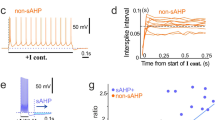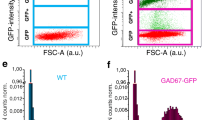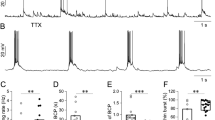Abstract
Rebound depolarization (RD) is a response to the offset from hyperpolarization of the neuronal membrane potential and is an important mechanism for the synaptic processing of inhibitory signals. In the present study, we characterized RD in neurons of the rat medial geniculate body (MGB), a nucleus of the auditory thalamus, using whole-cell patch-clamp and brain slices. RD was proportional in strength to the duration and magnitude of the hyperpolarization; was effectively blocked by Ni2+ or Mibefradil; and was depressed when the resting membrane potential was hyperpolarized by blocking hyperpolarization-activated cyclic nucleotide-gated (HCN) channels with ZD7288 or by activating G-protein-gated inwardly-rectifying K+ (GIRK) channels with baclofen. Our results demonstrated that RD in MGB neurons, which is carried by T-type Ca2+ channels, is critically regulated by HCN channels and likely by GIRK channels.








Similar content being viewed by others
References
Grenier F, Timofeev I, Steriade M. Leading role of thalamic over cortical neurons during postinhibitory rebound excitation. Proc Natl Acad Sci U S A 1998, 95: 13929–13934.
Zheng N, Raman IM. Ca currents activated by spontaneous firing and synaptic disinhibition in neurons of the cerebellar nuclei. J Neurosci 2009, 29: 9826–9838.
Yu YQ, Xiong Y, Chan YS, He J. Corticofugal gating of auditory information in the thalamus: an in vivo intracellular recording study. J Neurosci 2004, 24: 3060–3069.
Hu B, Mooney DM. Burst firing induces a slow after hyperpolarization in rat auditory thalamus. Neurosci Lett 2005, 375: 162–164.
Bartlett EL, Smith PH. Anatomic, intrinsic, and synaptic properties of dorsal and ventral division neurons in rat medial geniculate body. J Neurophysiol 1999, 81: 1999–2016.
Sun H, Wu SH. Physiological characteristics of postinhibitory rebound depolarization in neurons of the rat’s dorsal cortex of the inferior colliculus studied in vitro. Brain Res 2008, 1226: 70–81.
Felix RA, 2nd, Fridberger A, Leijon S, Berrebi AS, Magnusson AK. Sound rhythms are encoded by postinhibitory rebound spiking in the superior paraolivary nucleus. J Neurosci 2011, 31: 12566–12578.
Kopp-Scheinpflug C, Tozer AJ, Robinson SW, Tempel BL, Hennig MH, Forsythe ID. The sound of silence: ionic mechanisms encoding sound termination. Neuron 2011, 71: 911–925.
Wang X, Yu G, Hou X, Zhou J, Yang B, Zhang L. Rebound bursts in GABAergic neurons of the thalamic reticular nucleus in postnatal mice. Physiol Res 2010, 59: 273–280.
Tennigkeit F, Schwarz DW, Puil E. Modulation of bursts and high-threshold calcium spikes in neurons of rat auditory thalamus. Neuroscience 1998, 83: 1063–1073.
Tennigkeit F, Schwarz DW, Puil E. GABA(B) receptor activation changes membrane and filter properties of auditory thalamic neurons. Hear Res 1998, 122: 18–24.
Large EW, Crawford JD. Auditory temporal computation: interval selectivity based on post-inhibitory rebound. J Comput Neurosci 2002, 13: 125–142.
Casseday JH, Ehrlich D, Covey E. Neural tuning for sound duration: role of inhibitory mechanisms in the inferior colliculus. Science 1994, 264: 847–850.
Arcelli P, Frassoni C, Regondi MC, De Biasi S, Spreafico R. GABAergic neurons in mammalian thalamus: a marker of thalamic complexity? Brain Res Bull 1997, 42: 27–37.
Winer JA, Larue DT. Evolution of GABAergic circuitry in the mammalian medial geniculate body. Proc Natl Acad Sci U S A 1996, 93: 3083–3087.
Zhang Z, Liu CH, Yu YQ, Fujimoto K, Chan YS, He J. Corticofugal projection inhibits the auditory thalamus through the thalamic reticular nucleus. J Neurophysiol 2008, 99: 2938–2945.
Saint Marie RL, Stanforth DA, Jubelier EM. Substrate for rapid feedforward inhibition of the auditory forebrain. Brain Res 1997, 765: 173–176.
Lee CC, Sherman SM. Topography and physiology of ascending streams in the auditory tectothalamic pathway. Proc Natl Acad Sci U S A 2010, 107: 372–377.
Kimura A, Donishi T, Okamoto K, Tamai Y. Topography of projections from the primary and non-primary auditory cortical areas to the medial geniculate body and thalamic reticular nucleus in the rat. Neuroscience 2005, 135: 1325–1342.
Winer JA, Saint Marie RL, Larue DT, Oliver DL. GABAergic feedforward projections from the inferior colliculus to the medial geniculate body. Proc Natl Acad Sci U S A 1996, 93: 8005–8010.
Peruzzi D, Bartlett E, Smith PH, Oliver DL. A monosynaptic GABAergic input from the inferior colliculus to the medial geniculate body in rat. J Neurosci 1997, 17: 3766–3777.
Yu YQ, Xiong Y, Chan YS, He J. In vivo intracellular responses of the medial geniculate neurones to acoustic stimuli in anaesthetized guinea pigs. J Physiol 2004, 560: 191–205.
Ulrich D, Huguenard JR. GABA(A)-receptor-mediated rebound burst firing and burst shunting in thalamus. J Neurophysiol 1997, 78: 1748–1751.
Schwarz DW, Tennigkeit F, Adam T, Finlayson P, Puil E. Membrane properties that shape the auditory code in three nuclei of the central nervous system. J Otolaryngol 1998, 27: 311–317.
Luo B, Wang HT, Su YY, Wu SH, Chen L. Activation of presynaptic GABAB receptors modulates GABAergic and glutamatergic inputs to the medial geniculate body. Hear Res 2011, 280: 157–165.
Hibino H, Inanobe A, Furutani K, Murakami S, Findlay I, Kurachi Y. Inwardly rectifying potassium channels: their structure, function, and physiological roles. Physiol Rev 2010, 90: 291–366.
Quayle JM, McCarron JG, Brayden JE, Nelson MT. Inward rectifier K+ currents in smooth muscle cells from rat resistance-sized cerebral arteries. Am J Physiol 1993, 265: C1363–1370.
Franchini L, Levi G, Visentin S. Inwardly rectifying K+ channels influence Ca2+ entry due to nucleotide receptor activation in microglia. Cell Calcium 2004, 35: 449–459.
Margeta-Mitrovic M, Mitrovic I, Riley RC, Jan LY, Basbaum AI. Immunohistochemical localization of GABA(B) receptors in the rat central nervous system. J Comp Neurol 1999, 405: 299–321.
Padgett CL, Slesinger PA. GABAB receptor coupling to G-proteins and ion channels. Adv Pharmacol 2010, 58: 123–147.
Surges R, Sarvari M, Steffens M, Els T. Characterization of rebound depolarization in hippocampal neurons. Biochem Biophys Res Commun 2006, 348: 1343–1349.
Molineux ML, Mehaffey WH, Tadayonnejad R, Anderson D, Tennent AF, Turner RW. Ionic factors governing rebound burst phenotype in rat deep cerebellar neurons. J Neurophysiol 2008, 100: 2684–2701.
Tadayonnejad R, Anderson D, Molineux ML, Mehaffey WH, Jayasuriya K, Turner RW. Rebound discharge in deep cerebellar nuclear neurons in vitro. Cerebellum 2010, 9: 352–374.
Perez-Reyes E. Molecular physiology of low-voltage-activated T-type calcium channels. Physiol Rev 2003, 83: 117–161.
Carbone E, Lux HD. A low voltage-activated calcium conductance in embryonic chick sensory neurons. Biophys J 1984, 46: 413–418.
Huguenard JR. Low-threshold calcium currents in central nervous system neurons. Annu Rev Physiol 1996, 58: 329–348.
Destexhe A, Neubig M, Ulrich D, Huguenard J. Dendritic low-threshold calcium currents in thalamic relay cells. J Neurosci 1998, 18: 3574–3588.
Munsch T, Budde T, Pape HC. Voltage-activated intracellular calcium transients in thalamic relay cells and interneurons. Neuroreport 1997, 8: 2411–2418.
Errington AC, Renger JJ, Uebele VN, Crunelli V. State-dependent firing determines intrinsic dendritic Ca2+ signaling in thalamocortical neurons. J Neurosci 2010, 30: 14843–14853.
Yunker AM, McEnery MW. Low-voltage-activated (“T-Type”) calcium channels in review. J Bioenerg Biomembr 2003, 35: 533–575.
Tarasenko AN, Kostyuk PG, Eremin AV, Isaev DS. Two types of low-voltage-activated Ca2+ channels in neurones of rat laterodorsal thalamic nucleus. J Physiol 1997, 499 (Pt 1): 77–86.
Notomi T, Shigemoto R. Immunohistochemical localization of Ih channel subunits, HCN1-4, in the rat brain. J Comp Neurol 2004, 471: 241–276.
Moosmang S, Biel M, Hofmann F, Ludwig A. Differential distribution of four hyperpolarization-activated cation channels in mouse brain. Biol Chem 1999, 380: 975–980.
Luthi A, McCormick DA. Modulation of a pacemaker current through Ca(2+)-induced stimulation of cAMP production. Nat Neurosci 1999, 2: 634–641.
McCormick DA, Bal T. Sleep and arousal: thalamocortical mechanisms. Annu Rev Neurosci 1997, 20: 185–215.
Pape HC. Queer current and pacemaker: the hyperpolarization-activated cation current in neurons. Annu Rev Physiol 1996, 58: 299–327.
Steriade M, McCormick DA, Sejnowski TJ. Thalamocortical oscillations in the sleeping and aroused brain. Science 1993, 262: 679–685.
McCormick DA, Pape HC. Properties of a hyperpolarization-activated cation current and its role in rhythmic oscillation in thalamic relay neurones. J Physiol 1990, 431: 291–318.
Bal T, McCormick DA. What stops synchronized thalamocortical oscillations? Neuron 1996, 17: 297–308.
McCormick DA, Huguenard JR. A model of the electrophysiological properties of thalamocortical relay neurons. J Neurophysiol 1992, 68: 1384–1400.
Sutor B, Hablitz JJ. Influence of barium on rectification in rat neocortical neurons. Neurosci Lett 1993, 157: 62–66.
Fernandez-Alacid L, Watanabe M, Molnar E, Wickman K, Lujan R. Developmental regulation of G protein-gated inwardly-rectifying K+ (GIRK/Kir3) channel subunits in the brain. Eur J Neurosci 2011, 34: 1724–1736.
Karschin C, Schreibmayer W, Dascal N, Lester H, Davidson N, Karschin A. Distribution and localization of a G protein-coupled inwardly rectifying K+ channel in the rat. FEBS Lett 1994, 348: 139–144.
Ponce A, Bueno E, Kentros C, Vega-Saenz de Miera E, Chow A, Hillman D, et al. G-protein-gated inward rectifier K+ channel proteins (GIRK1) are present in the soma and dendrites as well as in nerve terminals of specific neurons in the brain. J Neurosci 1996, 16: 1990–2001.
Frere SG, Luthi A. Pacemaker channels in mouse thalamocortical neurones are regulated by distinct pathways of cAMP synthesis. J Physiol 2004, 554: 111–125.
Mao J, Li L, McManus M, Wu J, Cui N, Jiang C. Molecular determinants for activation of G-protein-coupled inward rectifier K+ (GIRK) channels by extracellular acidosis. J Biol Chem 2002, 277: 46166–46171.
Mao J, Wu J, Chen F, Wang X, Jiang C. Inhibition of G-protein-coupled inward rectifying K+ channels by intracellular acidosis. J Biol Chem 2003, 278: 7091–7098.
Whorton MR, MacKinnon R. Crystal structure of the mammalian GIRK2 K+ channel and gating regulation by G-proteins, PIP2, and sodium. Cell 2011, 147: 199–208.
Mark MD, Herlitze S. G-protein mediated gating of inward-rectifier K+ channels. Eur J Biochem 2000, 267: 5830–5836.
Andrade R, Malenka RC, Nicoll RA. A G protein couples serotonin and GABAB receptors to the same channels in hippocampus. Science 1986, 234: 1261–1265.
Zhang Y, Suga N. Corticofugal amplification of subcortical responses to single tone stimuli in the mustached bat. J Neurophysiol 1997, 78: 3489–3492.
Suga N, Gao E, Zhang Y, Ma X, Olsen JF. The corticofugal system for hearing: recent progress. Proc Natl Acad Sci U S A 2000, 97: 11807–11814.
He J. Corticofugal modulation of the auditory thalamus. Exp. Brain. Res. 2003, 153: 579–590.
Calford MB, Aitkin LM. Ascending projections to the medial geniculate body of the cat: evidence for multiple, parallel auditory pathways through thalamus. J Neurosci 1983, 3: 2365–2380.
Conley M, Kupersmith AC, Diamond IT. The organization of projections from subdivisions of the auditory cortex and thalamus to the auditory sector of the thalamic reticular nucleus in Galago. Eur J Neurosci 1991, 3: 1089–1103.
Cueni L, Canepari M, Lujan R, Emmenegger Y, Watanabe M, Bond CT, et al. T-type Ca2+ channels, SK2 channels and SERCAs gate sleep-related oscillations in thalamic dendrites. Nat Neurosci 2008, 11: 683–692.
Feng S, He Z, Li H, Wang Y. Ca(2+) signaling initiated by canonical transient receptor potential channels in dendritic development. Neurosci Bull 2015, 31: 351–356.
He J, Hu B. Differential distribution of burst and single-spike responses in auditory thalamus. J Neurophysiol 2002, 88: 2152–2156.
Swadlow HA, Gusev AG. The impact of ‘bursting’ thalamic impulses at a neocortical synapse. Nat Neurosci 2001, 4: 402–408.
Sherman SM. Tonic and burst firing: dual modes of thalamocortical relay. Trends Neurosci 2001, 24: 122–126.
Fu ZY, Mei HX, Cheng L, Bai J, Tang J, Jen PH, et al. Local neuronal circuits that may shape the discharge patterns of inferior collicular neurons. Neurosci Bull 2013, 29: 541–552.
Guido W, Lu SM, Sherman SM. Relative contributions of burst and tonic responses to the receptive field properties of lateral geniculate neurons in the cat. J Neurophysiol 1992, 68: 2199–2211.
Cotillon-Williams N, Huetz C, Hennevin E, Edeline JM. Tonotopic control of auditory thalamus frequency tuning by reticular thalamic neurons. J Neurophysiol 2008, 99: 1137–1151.
Massaux A, Dutrieux G, Cotillon-Williams N, Manunta Y, Edeline JM. Auditory thalamus bursts in anesthetized and non-anesthetized states: contribution to functional properties. J Neurophysiol 2004, 91: 2117–2134.
He J. Slow oscillation in non-lemniscal auditory thalamus. J. Neurosci. 2003, 23: 8281–8290.
Wallenstein GV. Simulation of GABAB-receptor-mediated K+ current in thalamocortical relay neurons: tonic firing, bursting, and oscillations. Biol Cybern 1994, 71: 271–280.
Takahashi H, Nakao M, Kaga K. Cortical mapping of auditory-evoked offset responses in rats. Neuroreport 2004, 15: 1565–1569.
Phillips DP, Hall SE, Boehnke SE. Central auditory onset responses, and temporal asymmetries in auditory perception. Hear Res 2002, 167: 192–205.
Aitkin LM, Prain SM. Medial geniculate body: unit responses in the awake cat. J Neurophysiol 1974, 37: 512–521.
He J. On and off pathways segregated at the auditory thalamus of the guinea pig. J Neurosci 2001, 21: 8672–8679.
Toronchuk JM, Stumpf E, Cynader MS. Auditory cortex neurons sensitive to correlates of auditory motion: underlying mechanisms. Exp. Brain Res. 1992, 88: 169–180.
He J, Hashikawa T, Ojima H, Kinouchi Y. Temporal integration and duration tuning in the dorsal zone of cat auditory cortex. J Neurosci 1997, 17: 2615–2625.
Acknowledgments
This work was supported by the National Basic Research Development Program of China (2011CB504506 and 2012CB932502), the National Natural Science Foundation of China (81570915, 81371503 and 31170965) and the Open Fund from CAS Key Laboratory of Brain Function and Diseases, China (2012-3).
Author information
Authors and Affiliations
Corresponding author
Electronic supplementary material
Below is the link to the electronic supplementary material.
Rights and permissions
About this article
Cite this article
Wang, XX., Jin, Y., Sun, H. et al. Characterization of Rebound Depolarization in Neurons of the Rat Medial Geniculate Body In Vitro . Neurosci. Bull. 32, 16–26 (2016). https://doi.org/10.1007/s12264-015-0006-5
Received:
Accepted:
Published:
Issue Date:
DOI: https://doi.org/10.1007/s12264-015-0006-5




